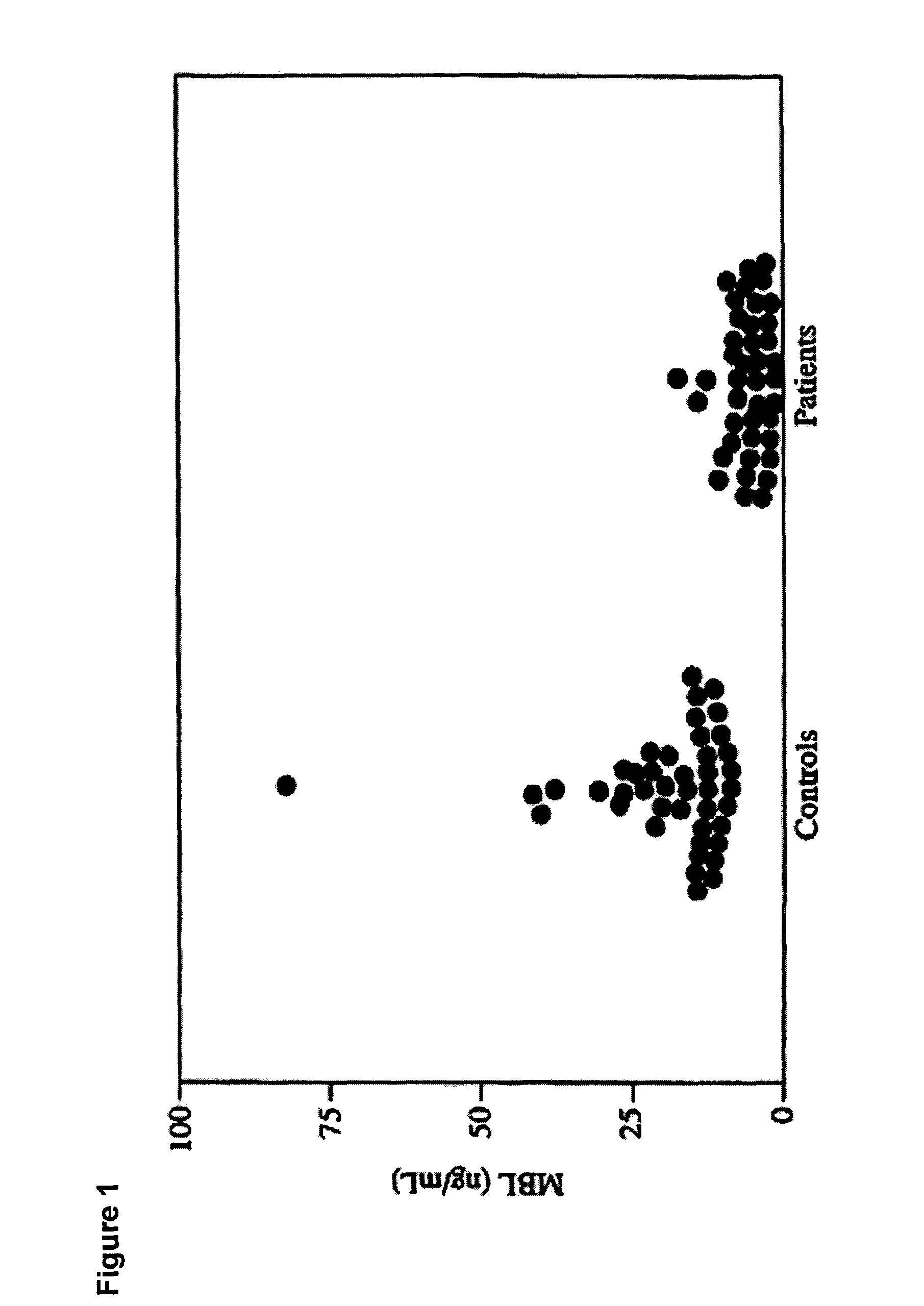Detecting recurrent vulvovaginal candidiasis or vulvar vestibulitis syndrome and method for treating same
a technology for vulvar vestibulitis and vulvovaginal candidiasis, which is applied in the direction of biocide, drug composition, peptide/protein ingredients, etc., can solve the problems of considerable morbidity and suffering, and achieve the effect of increasing the risk of vulvovaginal candidiasis or, increasing the risk of vulvovaginal candidiasis
- Summary
- Abstract
- Description
- Claims
- Application Information
AI Technical Summary
Benefits of technology
Problems solved by technology
Method used
Image
Examples
example 1
Materials and Methods for Vulvovaginal Candidiasis Study
[0071]The study population consisted of 42 women (age, 18-35 years) who had four or more culture-verified symptomatic episodes of a vulvovaginal Candida infection during a 12-month period and who currently had symptoms consistent with a vaginal Candida infection (i.e., pruritis, burning, and abnormal discharge) and a positive Candida culture. Control subjects were 43 women who had no current gynecologic complaints, who had no history of vaginal Candida infection, and who were currently culture-negative for pathogens. All patients and control subjects were seen at the outpatient obstetrics / gynecology department of Riga First Hospital in Riga, Latvia. Patients and control subjects were matched for age, socioeconomic and marital status, and number of children. All were ethnic Latvians. Exclusion criteria for this study were pregnancy, diabetes, known immunodeficiencies, use of immunosuppressive medications, or history of hysterect...
example 2
Demographic and Clinical Characteristics of Patients and Control Subjects
[0078]Demographic and clinical characteristics of patients and control subjects are detailed in Table 1 below. Candida albicans was detected in 38 (90.5%) of the patients with RVVC, Candida tropicalis was detected in 3 (7.1%), and Candida krusei was detected in 1 (2.4%). Among the control women, 4 cultures (9.3%) were positive for C. albicans. No other Candida species were detected in the control subjects. Ten patients with RVVC and none of the control subjects were positive for bacterial vaginosis. All patients and control subjects tested negative for T. vaginalis, C. trachomatis, N. gonorrhoea, and HIV.
[0079]
TABLE 1Demographic and Clinical Characteristics of Patients with RecurrentVulvovaginal Candidiasis (RVVC) and Control Subjects.Patients withRVVCControl subjectsCharacteristic(n = 42)(n = 43)Age, mean years (range)26.8(18-35)25.4(18-35)University education21(50)16(37.2)Salary 38.160.5Age at first sexual in...
example 3
Recurrent Vulvovaginal Candidiasis is Associated with a Gene Polymorphism in Mannose-Binding Lectin
[0081]The distribution of MBL alleles was significantly different in control subjects and patients with RVVC(PC. albicans were either allele B heterozygotes or homozygotes, 100% of the women positive for C. tropicalis were allele B heterozygotes, and the single woman with C. krusei infection was allele A homozygous.
[0082]
TABLE 2Relation Between Mannose-binding Lectin (MBL) GenePolymorphism and Recurrent Vulvovaginal Candidiasis (RVVC).No. (%) of subjectsRVVC groupControl groupMBL genotype(n = 42)(n = 43)AA13 (31.0)a39 (90.7)AB26 (61.9)b 4 (9.3)BB 3 (7.1) 0 (0)aP bP
[0083]Although the number of subjects is small, there was no relationship between bacterial vaginosis and MBL genotype. Allele A homozygotes, allele A / B heterozygotes, and allele B homozygotes were present in 30%, 50%, and 20% of the patients with bacterial vaginosis, respectively.
PUM
| Property | Measurement | Unit |
|---|---|---|
| concentrations | aaaaa | aaaaa |
| temperature | aaaaa | aaaaa |
| temperature | aaaaa | aaaaa |
Abstract
Description
Claims
Application Information
 Login to View More
Login to View More - R&D
- Intellectual Property
- Life Sciences
- Materials
- Tech Scout
- Unparalleled Data Quality
- Higher Quality Content
- 60% Fewer Hallucinations
Browse by: Latest US Patents, China's latest patents, Technical Efficacy Thesaurus, Application Domain, Technology Topic, Popular Technical Reports.
© 2025 PatSnap. All rights reserved.Legal|Privacy policy|Modern Slavery Act Transparency Statement|Sitemap|About US| Contact US: help@patsnap.com


